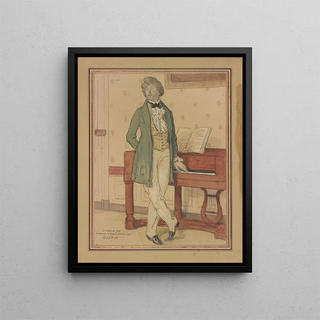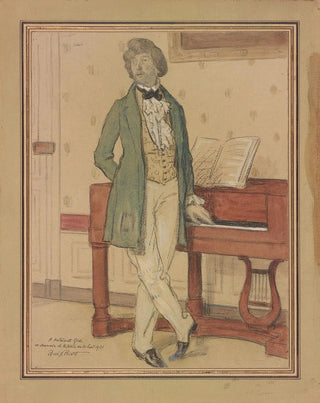Art print | Study of a young man next to a piano - René François Xavier Prinet Source: Reproduction | Étude d'un jeune homme à côté d'un piano - René François Xavier Prinet


View from behind

Frame (optional)
The artwork "Study of a Young Man Next to a Piano" by René François Xavier Prinet is an invitation to immerse oneself in the intimate world of music and youth. This painting, where light and shadow blend harmoniously, depicts a young man lost in thought, seated beside a piano, a symbol of creativity and expression. The posture of the figure, both dreamy and contemplative, evokes a moment of pause, a suspended instant where the melody seems to escape from the black and white keys. Prinet masterfully captures an atmosphere imbued with delicacy and sensitivity, offering a glimpse into the artistic soul of the early 20th century.
Style and uniqueness of the work
Prinet's style is distinguished by its naturalist approach, while incorporating impressionist elements that infuse his compositions with lightness and fluidity. In "Study of a Young Man Next to a Piano," the colors are subtly nuanced, creating a play of light that highlights the delicate features of the young man. The background, blurred and slightly abstract, allows focus on the main subject, while suggesting the depth of a warm interior. Prinet's brushwork, both precise and free, gives the piece a lively, almost tangible dimension. This work is not limited to a simple portrait but transforms into a true ode to music and youth, where every detail tells a story.
The artist and his influence
René François Xavier Prinet, born in 1861, was an artist whose career was marked by an ongoing quest for harmony between art and everyday life. Influenced by the artistic movements of his time, notably symbolism and impressionism, Prinet developed a unique style that is his own. His ability to translate human emotions through scenes of daily life makes him an emblematic artist of his era. His works, often populated with melancholic and dreamy figures, reflect a deep contemplation of the human condition. Prinet also played a role in mentoring young artists, sharing

Matte finish

View from behind

Frame (optional)
The artwork "Study of a Young Man Next to a Piano" by René François Xavier Prinet is an invitation to immerse oneself in the intimate world of music and youth. This painting, where light and shadow blend harmoniously, depicts a young man lost in thought, seated beside a piano, a symbol of creativity and expression. The posture of the figure, both dreamy and contemplative, evokes a moment of pause, a suspended instant where the melody seems to escape from the black and white keys. Prinet masterfully captures an atmosphere imbued with delicacy and sensitivity, offering a glimpse into the artistic soul of the early 20th century.
Style and uniqueness of the work
Prinet's style is distinguished by its naturalist approach, while incorporating impressionist elements that infuse his compositions with lightness and fluidity. In "Study of a Young Man Next to a Piano," the colors are subtly nuanced, creating a play of light that highlights the delicate features of the young man. The background, blurred and slightly abstract, allows focus on the main subject, while suggesting the depth of a warm interior. Prinet's brushwork, both precise and free, gives the piece a lively, almost tangible dimension. This work is not limited to a simple portrait but transforms into a true ode to music and youth, where every detail tells a story.
The artist and his influence
René François Xavier Prinet, born in 1861, was an artist whose career was marked by an ongoing quest for harmony between art and everyday life. Influenced by the artistic movements of his time, notably symbolism and impressionism, Prinet developed a unique style that is his own. His ability to translate human emotions through scenes of daily life makes him an emblematic artist of his era. His works, often populated with melancholic and dreamy figures, reflect a deep contemplation of the human condition. Prinet also played a role in mentoring young artists, sharing






